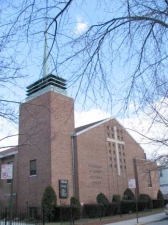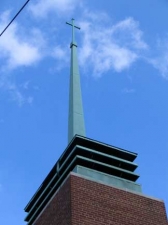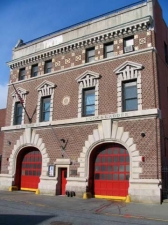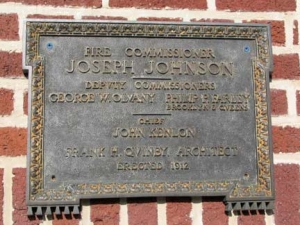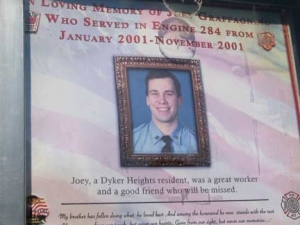I was at my dentist on Saturday, March 1st, 2008 for the first time in three years, and found I had chalked up 4 cavities. I mention this because some of my most fruitful ForgottenTrips have been made after a trip to the dentist. I had to make an emergency visit with a toothache on Christmas Eve a number of years ago and, finding myself in western Brooklyn, proceeded to walk Kings Highway from Bensonhurst all the way to Flatbush.
That was the case March 1st., as well. My walk on 18th Avenue on Christmas Eve, 2007 reminded me that not only had I neglected Bay Ridge’s sister neighborhoods Bensonhurst and Dyker Heights, I had forgotten about them even when I lived there.
Your webmaster is hopelessly, intractably wedded to habit, especially where food is concerned. There are about a dozen things that I eat. (Just recently, not one but two attractive women have told me my diet cola addiction will kill me prematurely, or at least affect my health negatively. I listen to attractive women, since so few of them will speak to me. But I have yet to break the addiction.) So, you will not be surprised to learn that there was a time, from about 1982 to 1988 or so, that I could be found in a Blimpie on 2nd Avenue and East 45th Street In Manhattan every Friday morning at 2AM eating a pepperoni sandwich. (I worked overnights at Photo-Lettering then as a typesetter and copyfitter — a business and a profession that have since become Forgotten.) And yet, I walk among you today.
For an even greater span of time, without fail, I could be found every Monday, in the late afternoons and early evenings, from about 1982 through 1993, at Zeke’s Roast Beef on 8th Avenue and 66th Street on the Bay Ridge-Dyker Heights border. It was terrific – it had a free salad bar with fresh lettuce, tomato and onions. Why would anyone stop such a thing? I visited regularly even after moving out of Bay Ridge. I was giving a presentation recently at Word Books in Greenpoint and after mentioning Zeke’s, I noticed a woman in the audience nodding her head. She mentioned afterward that she, too, was a Zeke’s addict. In 2006, though, it became a Chinese restaurant. I have a question: in Asian neighborhoods, why do 95% of the restaurants have to serve Asian food? Well, that and Starbucks? On this trip into Dyker Heights, I substituted Nathan’s Famous at 7th Avenue and 86th Street, even though I realize a steady diet of Nathan’s fare will finish me sooner than pepperoni sandwiches and diet Coke. Or will it? I still walk among you today.
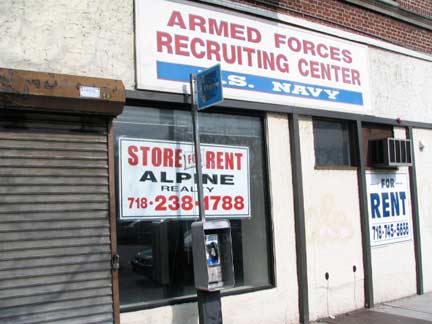
After leaving the dentist office I began the excellent Dyker Heights adventure by heading west along 86th Street. This recruitment office at 86th and the Gowanus Expressway has been there as long as I remember. Business is bad lately, understandably, I suppose.
WAYFARING: DYKER HEIGHTS (open in separate window)
After lunch, I decided to head over to 83rd Street between 7th and 10th Avenues (8th and 9th Avenues show up northeast of here) at a building whose spire I had always noticed while living across the expressway on 6th Avenue and 83rd for years…
It is the Redeemer St. John’s Lutheran Church. The congegation has been here since 1925, but gthis Modernist building, with its thin green spire that can be seen for quite a distance around, was built in 1960.
There are a number of Lutheran churches, I discovered, in my trips around Bay Ridge and today’s in Dyker Heights. If I may generalize (there were a number of Norwegian kids in the Catholic school I attended as a kid, St. Anselm) the presence of so many Lutheran churches here is a reminder that western Brooklyn used to be dominated by Norwegians, Swedes, Finns, Danes, and Scandinavians in general. In May, Bay Ridge is still the venue for the metropolitan area’s only Norwegian Day Parade.
The name “Dyker” presents a bit of a puzzler for Brooklyn lexicologists. In Brooklyn By Name, Leonard Benardo and Jennifer Weiss assert that Dutch farmers who built dikes to drain the area’s wetlands in the colonial era gave it its name. However Van Dyke is a common Dutch name and a family of that name did have a hand in its development in the mid-1700s. Strictly speaking Dyker Heights was more strictly defined when the Gowanus Expressway was completed in 1964, as the neighborhood’s boundaries can be set at 86th Street (and the Dyker Park Golf Course, where Tiger Woods’ father Earl was a pro) the expressway, 65th Street, and 14th Avenue. It’s overwhelmingly residential and the only business streets are Fort Hamilton Parkway, 13th Avenue, and parts of 11th. The neighborhood is best-known and most heavily chronicled during the Christmas season, when many locals construct extravagant Christmas displays, especially along 84th Street between 11th and 12th Avenue.
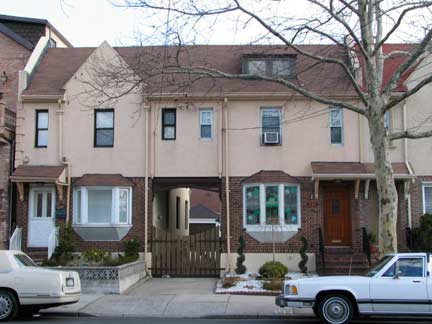
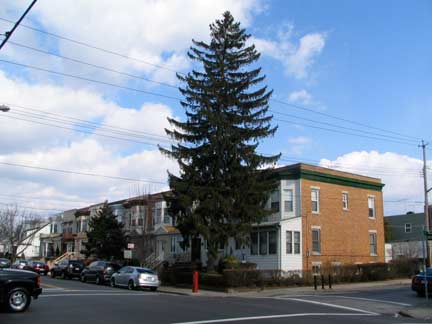
I always liked this unusually-constructed pair of buildings along 10th Avenue at 83rd Street. The building has an extension right over the driveway. At right (10th and 81st), we see something rather more representative of what you’ll find along 10th Avenue: small attached homes, some with driveways and garages in the back, some not. Now and then, there’s a tall pine to break the monotony. Most of these style houses were constructed in the 1920s; much of Dyker Heights was sparsely developed until then.
Right about here lived one of my high school classmates, a guy I’ll call Mike McG. He was a relentless needler in high school but when I saw him at a reunion in 2005, he had mellowed enough to actually carry on a conversation! Progress.

Bay Ridge Parkway, which everyone from around here calls 75th Street (since it’s between 74th and 76th.) No one has really accepted Bay Ridge Avenue and Bay Ridge Parkway as names for for 69th and 75th Streets, respectively, just as no one would stand for Avenue of the Americas instead of 6th Avenue. How are Adam Clayton Powell, Jr. Blvd. and Frederick Douglass Blvd. faring in lieu of 7th and 8th Avenues? Can anyone up there let me know? I can think of one case in which the substitute has been accepted: St. Mark’s Place isntead of East 8th Street from Cooper Square to Tomkpins Square Park.
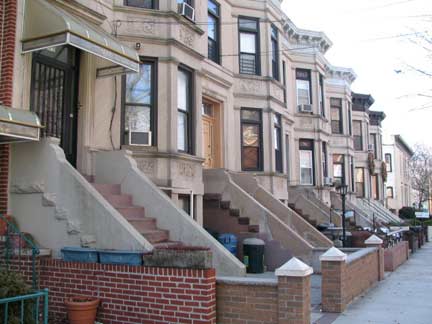
Above, a pair of scenes showing some new townhouses on the SE corner of 10th and 75th (I can say 75th, I’m from Bay Ridge). These replaced a fairly large mansion a few years ago. At right, some attached (limestone?) houses between Fort Hamilton Parkway and 10th Avenue. Homes like these dominate 75th between 4th and 6th Avenues (and many of them between 4th and 5th are occupied by eye doctors’ offices). These go to about halfway up the block toward 10th Avenue and peter out at that point.
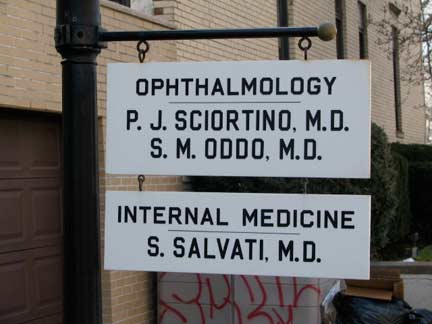
…and there’s a couple of ophthalmologists here, too. I photographed the sign because it’s part of a tradition that’s been fading the last decade or so…the doctor’s “shingle” that consists of a white enamel sign with block lettering stenciled in. Quiet, efficient, and effective.
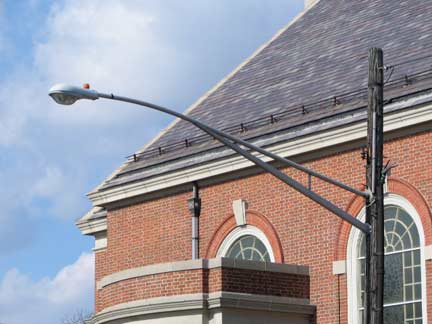
Between FHP and 10th Avenue, 75th Street boasts a flock of these double-masted telephone pole masts, which are relatively rare in NYC, though the stretch of Little Neck Parkway in my present neighborhood has a run of them. Dyker Heights’ lamppost history is complicated. In the early and mid 20th Century there were guy-wired t-pole masts that consisted of a thin pipe supporting the luminaire that was supported by a wire mounted above it. Later, they carried radial-wave lumes, and later “bells” and Westinghouse cuplights and then, during my youth, by myriads of these double-masters on the avenues that supported cuplights. In the mid-60s they were all removed in favor of the simple finned masts that have carried a number of both mercury and sodium lights over the years. I should also mention that in the 1980s, all of Dyker Heights’ telephone poles were replaced by new ones, and they all went on the opposite side of the street from the originals. This one, though, is one of the oldies.
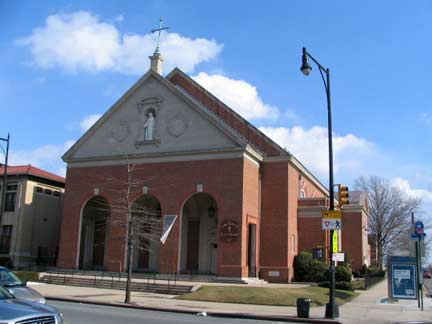
St. Ephrem’s Church, 75th Street and Fort Hamilton Parkway. Information online about the church is hard to come by, but I believe the church is “relatively” new, dating to the 1950s. Growing up in Bay Ridge, I lived near a pair of Catholic churches commemorating saints I had never heard of, Anselm and Ephrem (we read sants’ lives as children). Anselm (1033-1109) was a Burgundian (today’s Italy) theologist and philosopher, who held the post of Archbishop of Canterbury while Ephrem (306-373) was a Syrian hymnist, theologian and deacon. It’s fitting that Bay Ridge, which has had many Syrian and Middle Eastern Catholics, would have a parish named for a Syrian.
St. Ephrem holds a place in New York Mets history, well, at least my personal Mets history. In October 1986 the Mets were playing the Houston Astros in a playoff game on the very Saturday afternoon my cousin Eileen was going to get married here, at St. Ephrem. The wedding was at four; Lenny Dykstra hit the game winning blast at 3:30; and since I was living in an apartment at 7th Avenue and 73rd Street at the time, I strolled across McKinley Park to the church (see next stop) just after the ball sailed over the fence.
I was an usher and I had to wear a pink bow tie.
McKinley Park
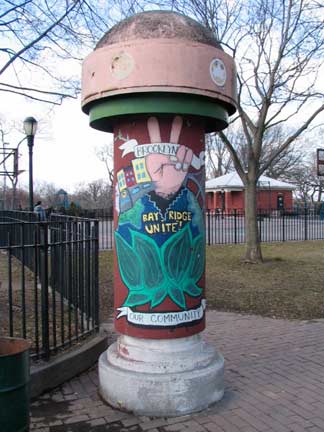
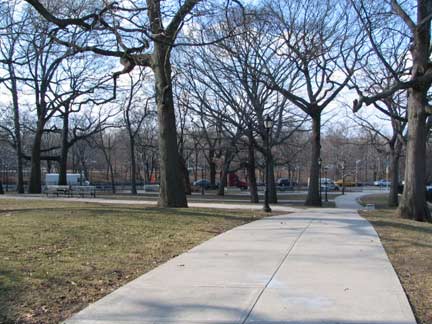
McKinley Park is triangle-shaped plot between 7th Avenue, Fort Hamilton Parkway and 73rd Street, with a neat bisection by 75th Street. The southern half contains basketball and tennis courts, while the northern has a playground, park house, and grassy park paths.
McKinley Park was completed by the Parks Department in 1903 and named for the USA’s 25th President, William McKinley (1843-1901), who was felled by an assassin’s bullet on September 6, 1901 and succeeded by Vice-President Theodore Roosevelt. Under McKinley the USA was the victor in the Spanish-American War and annexed Puerto Rico, Guam, Hawaii, American Samoa, and the Philippines.

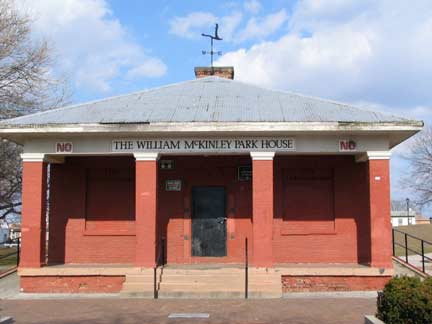
McKinley Park retains rolling hills that have been mostly flattened elsewhere in the neighborhood. The central hill with the flagpole is ideal for sledding in wintyers when NYC gets a lot of snow (which is not every year any more). Photo right: your webmaster would ascend this hill to get a glimpse of my bathroom and back-room windows, which could be seen from here the years I was in my apartment on 7th and 73rd (1982-1990). Despite being underinsulated and underheated it remains my favorite apartment; I had a view of the Verrazano Bridge in winter, McKinley Park, and from the roof, the Williamsburg Bank tower. It was a railroad flat consisting of 4 rooms (the kitchen and living room made up one large room) and got sun from three exposures. I was working nights then and slept between 7AM and about 1PM, so I saw a lot of sun. I had all the time in the world for Forgottening then, but the concept, as well as the internet, wouldn’t come along until 10 years had gone by.
At left in the top photo we see William McKinley Junior High School on Fort Hamilton Parkway, which I continued along…
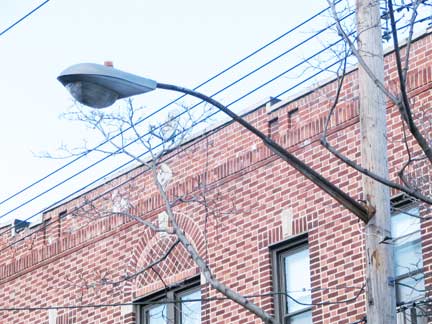

Above: on 72nd Street east of FHP, a General Electric M400 luminaire hangs in there. On 73rd, we see a battered NYC “ice cream cone” fire alarm, likely going back to the 1910s or 1920s. Many of NYC’s fire alarms have been decommissioned because of rampant false alarms.
The M400 was purged in a citywide streetlamp replacement program in 2009.
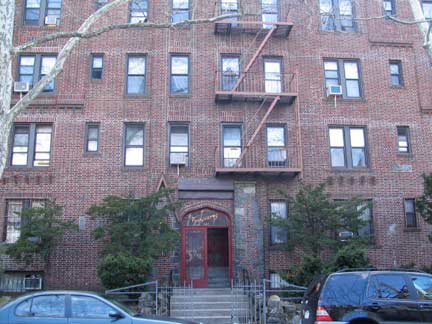
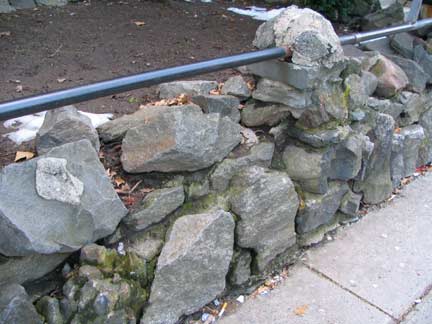
I favor brick buildings in general…I have never lived in anything but a brick building…and I especially like this one on 72nd east of FHP because of its irregular stone fence.
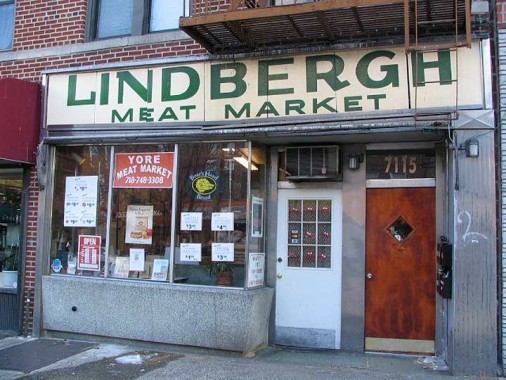
This was my meat market (7115 Fort Hamilton Parkway) when I lived in the immediate vicinity from 1982-1991 and, while it’s been “Yore Butcher” for several years now, I’m glad they preserved its glorious beige and green enamel sign. It could very well date back to the era of Lucky Lindy‘s trans-Atlantic flight in 1927 and may be another manifestation of Scandinavian pride in Bay Ridge, since Lindbergh was of Swedish extraction. The Norwegian Day parade was formerly routed along both 8th Avenue and FHP; it is now on 5th Avenue.
For a 9-letter word, “Lindbergh” has just two vowels. That must be a record.
Nope. Pittsburgh.
Oops…Plattsburgh, NY
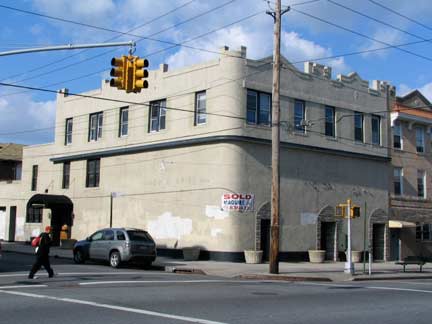
The castellated building (I learned that word just last week) at FHP and 70th Street is the former Joseph V. Sessa Funeral Home, which has since moved to 3rd Avenue and 82nd Street. Some funeral homes have their histories on their websites, but Sessa has neither.
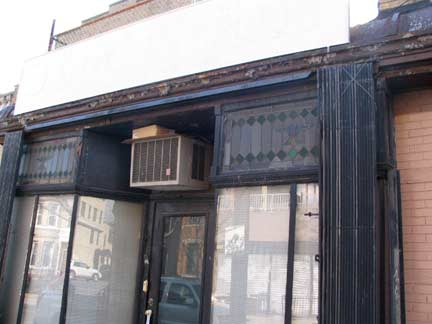
An ancient, stained-glassed storefront on 70th just east of FHP.
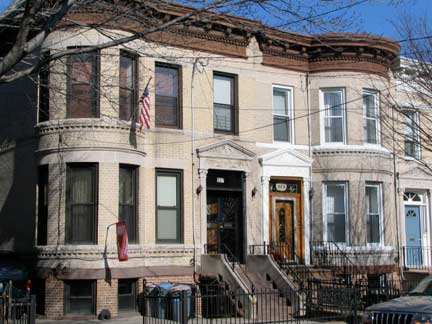
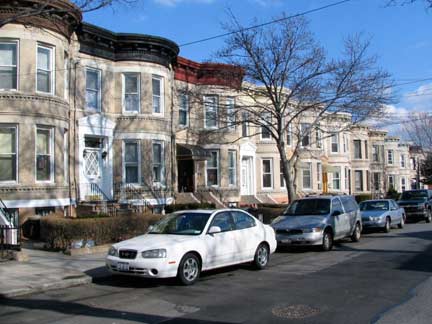
Compare eras…two periods of architecture that have nothing to say to the other. Even though there’s not much lawn to be had at the attached bay-windowed brick buildings on the north side of 70th Street, each has a differently designed or painted door, and many of them have hedges in front of their basement-apartment entrances.
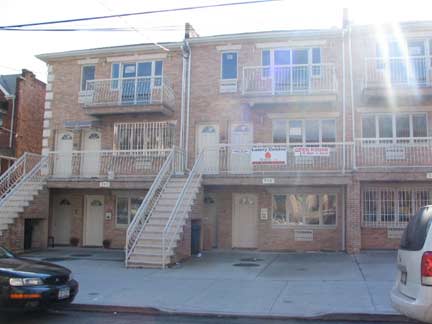
On the south side of the street are brand new worker storage units, complete with monster van space in front.
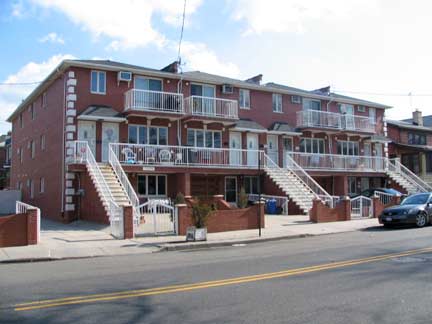
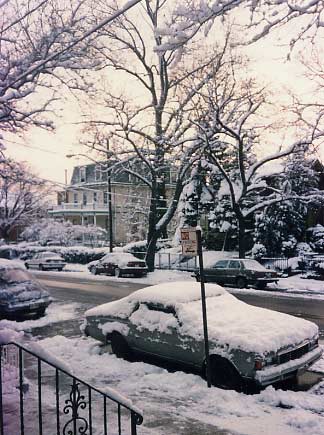
Some slightly better built objects at the SE corner of 10th Avenue and 70th Street. They replaced a magnificent cream and green porched house that you can make out at the left side of the photo on the right. Somewhere in Fibber McWalsh’s closet is a full frontal photo. Of that house.
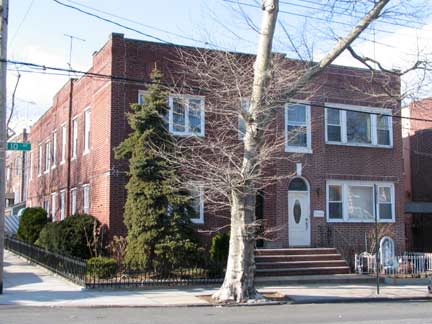
10th Avenue and 71st Street. This is a house that your webmaster lived in, albeit rather briefly, from November 1990 through November 1991. I was reluctant to move from 73rd Street, but the owner pulled the old gag that his daughter needed the apartment, which I foolishly believed. A few months later the newly renovated flat was offered to me again at a 75% markup. No thanks. I rented the bottom floor of the house on the corner. It was 6 rooms, but for a figure I really couldn’t afford at the time, and after a robbery over the summer, I went to my original building on 6th Avenue where I had spent my childhood when the old man found me a cheaper apartment in that building. My year here was relatively unhappy, though if I could afforded it, it would have been better, I suppose. It was the most space I had ever had.
The building resembles the one I live in now, in Little Neck.
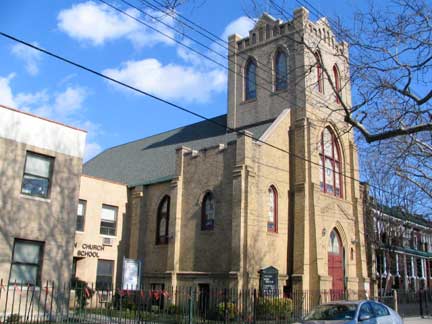
Here’s the gloriously yellow-bricked Bethany Lutheran Church on 72nd between 10th and 11th Avenues. To emphasize any remaining Scandinavian heritage, the adjutant school is named for Lief Ericson.
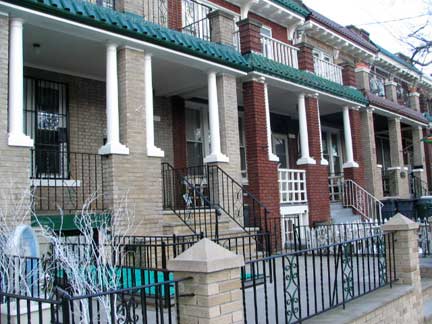
This porched style is frequently found in Windsor Terrace but is also here on 72nd Street just east of the church.

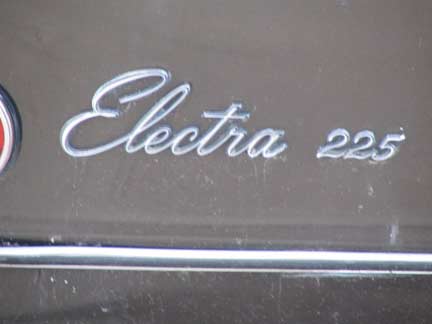
Buick Electra 225, 11th Avenue and 80th Street. The Electra 225 was produced from 1959-1980: what year was this one? (A ’69, I’m told)
St. Philip’s
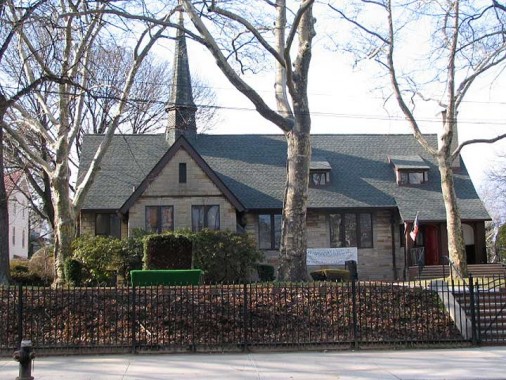
St. Philip’s Episcopal Church occupies the entire frontage on 11th Avenue from 80th-81st Streets. According to the church’s website, St. Philip’s was completed in 1900, with the steeple added in 1907. It has been called “The Little Country Church on the Hill” and must have originally served farms and isolated homesteads in the region.
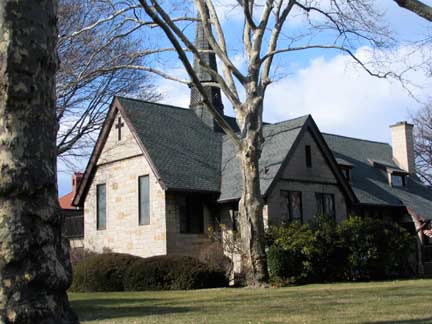
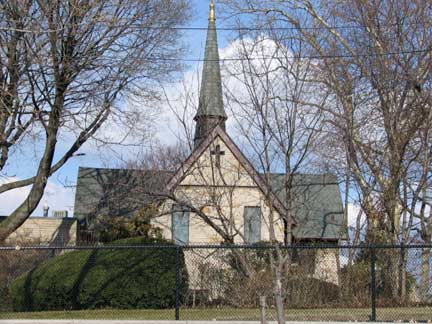
According to the church, the two windows on the south side of the sanctuary (shown here) are Tiffanys.
Philip, whose feast day is May 11th, was one of the Twelve Apostles. He is not often mentioned in the Gospels (mostly in John) but some there are some episodes…
• Before the miraculous feeding of the multitude, Christ turns towards Philip with the question: “Whence shall we buy bread, that these may eat?” to which the Apostle answers: “Two hundred penny-worth of bread is not sufficient for them, that every one may take a little” (John vi, 5-7).
• When some heathens in Jerusalem came to Philip and expressed their desire to see Jesus, Philip reported the fact to Andrew and then both brought the news to the Saviour (xii, 21-23).
• When Philip, after Christ had spoken to His Apostles of knowing and seeing the Father, said to Him: “Lord, shew us the Father, and it is enough for us”, he received the answer: “He that seeth me, seeth the Father also” (xiv, 8-9). Catholic Encyclopedia
He was a friend of Bartholomew (a.k.a Nathaniel) and is often mentioned with him.
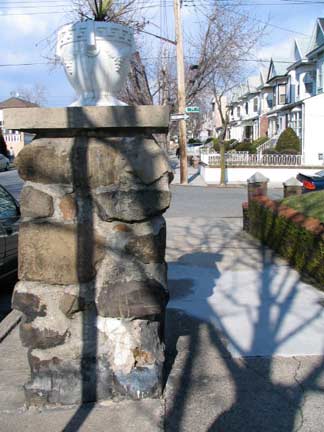
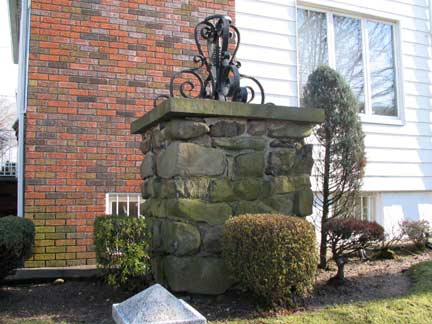
Present or former real estate development tracts from various decades throughout the city are often marked by decorative gate posts. At 11th Avenue and 79th Street, on both sides of the avenue, are a tremendous example of the genre.
The ones on the sidewalks feature decorative urns, while the inner pair are placed right on private lawns and have scrolled ironwork at the top. Wonderful stuff.
As its plaque indicates, FDNY Engine 284 was constructed in 1912 and was likely the first building on 79th Street between 11th and 12th Avenues. The house lost one of its former firefighters, Joseph Graffagnino, on Saturday, August 18, 2007 as he fought a blaze in the condemned Deutsch Bank Building near the World Trade Center site. Graffagnino was a part of Engine 284’s deployment to the WTC on 9/11/01.
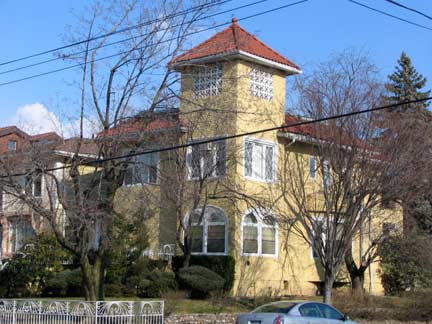
There’s a pair of “twin tower” houses on 12th Avenue on 77th and a block north at 76th. This one, on 77th, has been covered with stucco, but that’s OK. Better than siding.
As I mentioned before, I was in Greenpoint earlier in the week and as is well-known, much of Greenpoint is covered with aluminum siding; not so much in other Brooklyn neighborhoods. I wonder how that came about.
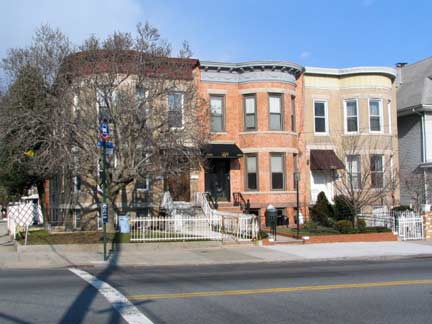
Some pleasant attached brick buildings at the NE corner of 12th Avenue and Bay (75th Street) Ridge Parkway.
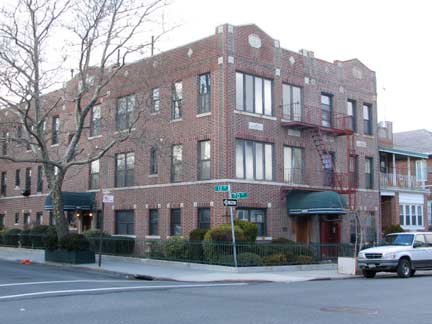
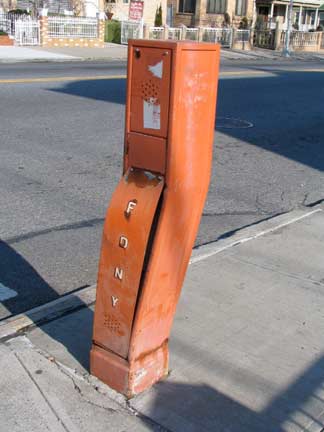
Pleasantly solid brick construction at 12th and 70th, and another bloodied and bowed ex-fire alarm, this one a streamlined 1960s design.
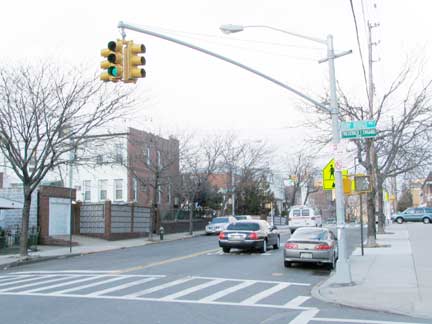

Two schools of stoplight streetlight mounting, at Bay Ridge Avenue (69th Street) top, and a block north at Ovington Avenue and 12th Avenue (bottom). Both of these methods are still relatively rare, since the DOT prefers cobra neck masts, pretty much to get the streetlight out of the way of the stoplights. The lowboy on the left is especially hard to find. In the 1990s, the DOT began plopping retro-longneck Corvington, bishop crook, and even Type F reverse-scrolls on top of the 1950s-era guy-wired stoplight posts. Which is heresy, according to your webmaster.
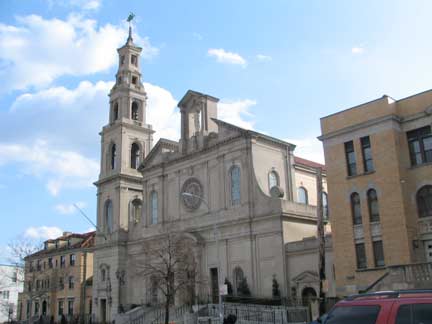
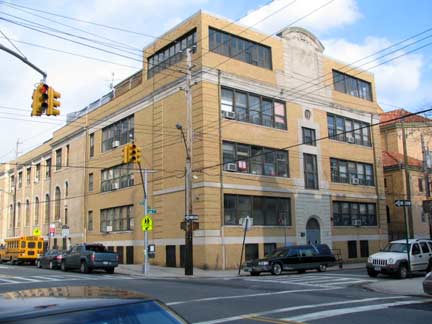
Bigger is better at Regina Pacis (Queen of Peace) Church, both for the church and its grade school, on 12th from 65th to 66th Streets. It is the tallest structure by far in Dyker Heights.
When you get to 65th Street, make a left turn and you’ll find yourself in front of a beautiful church, Regina Pacis. Years ago, a jeweled chalice was stolen from the sanctuary. Old man Profaci, the founder of the Colombo Family, put word on the street that the chalice was to be returned. It was… [American Mafia]
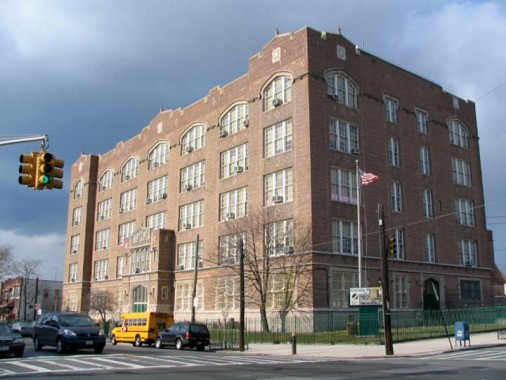

IS 187, on the other corner of 65th Street and 12th Avenue, is the Christa McAuliffe School.
Christa McAuliffe was a civilian mission specialist aboard the Challenger Space Shuttle, and died with the rest of the seven member crew when Challenger exploded 73 seconds after launch on January 28, 1986.
Christa McAuliffe graduated from Framington State College, Massachusetts, in 1970 with a degree in history. A dedicated junior high school teacher (she taught history, social studies and civics), Christa McAuliffe was also a volunteer with her church, a Girl Scout Leader and a hospital and YMCA fundraiser.
Christa McAuliffe was scheduled to teach two lessons from the space shuttle. She was part of the NASA Teacher in Space project, selected as its primary candidate in 1985. She won out over 11,500 applicants; NASA officials were reportedly especially impressed with her course on “The American Woman” which she had developed and taught. Barbara Morgan was the backup “Teacher in Space” who also trained with NASA in the astronaut training program. [about.com]
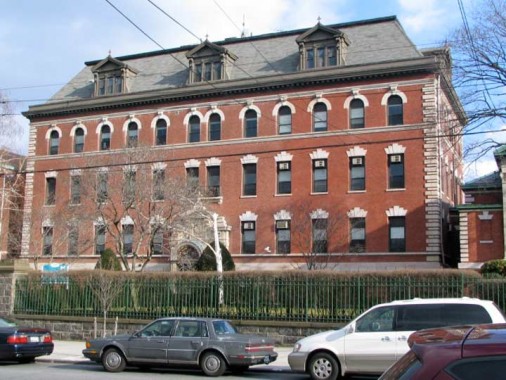
Occasionally Dyker Heights will surprise you with an aged building, like St. Philip Episcopal, or this one, between 63rd and 64th on 12th Avenue, the Angel Guardian Home (now Mercy First) which has sheltered unwed mothers and their children since 1899. In 1899 this part of town was far removed from anything else, but there was still a certain pride and dignity placed into the construction of housing for people who, in that era, were mostly shunned by society.
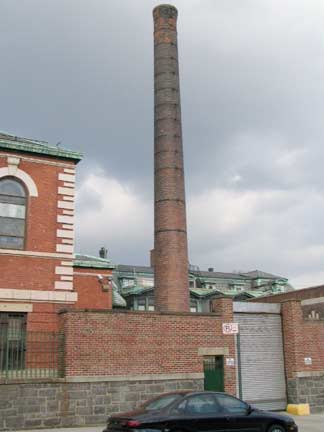
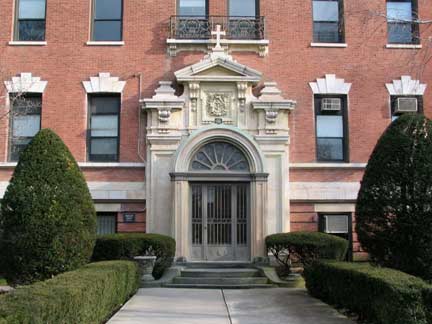
Some more detail of the Mercy first building. There is a large compound in the back completely surrounded by a high fence. You must love those window lintels.
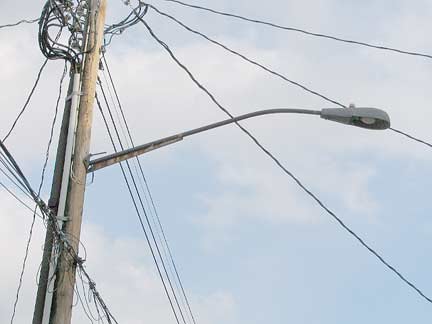
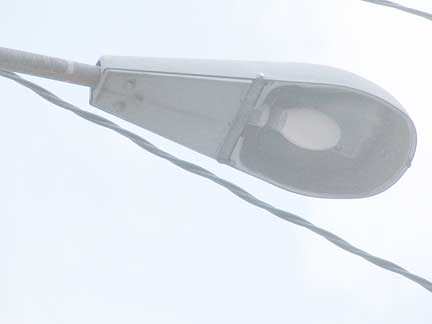
Westinghouse “scoop” lume on 63rd Street east of 13th Avenue. These first appeared in 1962-1963 or so and spread like wildfire to side streets all over the city (they were frequent in Philadelphia as well, as I recall.) Their reign only lasted about ten years, as in the early 1970s bright yellow sodium bulbs replaced the scoop’s weak green-white mercury glow.
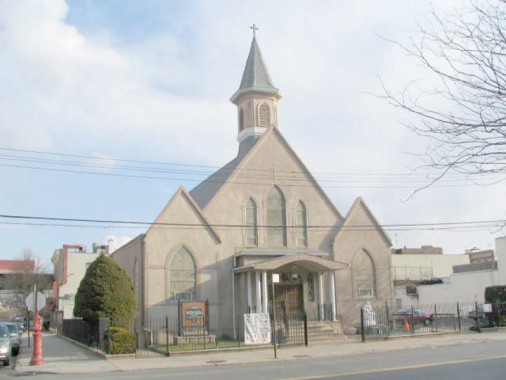
St. Rosalia Church, 63rd Street and 14th Avenue. A pleasantly small-in-scale church; compare the massive, even ostentatious, Regina Pacis. Rosalia (1130-1166) was a solitary and an anchoress, who lived alone in a cave for religious reasons, dedicating her life to Christ. She is perhaps venerated mostly for what happened after her death:
In 1624 a horrible plague haunted Palermo, and during this hardship St. Rosalia appeared first to a sick woman, then to a hunter to whom she indicated where her remains were to be found. She ordered him to bring her bones to Palermo and have them carried in procession through the city.
The hunter climbed the mountain and found her bones in the cave as described. He did what she had asked in the apparition, and after the procession the plague ceased. After this St. Rosalia would be venerated as the patron saint of Palermo, and a sanctuary was built in the cave where her remains were discovered. wikipedia
The history of Dyker Heights had been something of a mystery until recently, for me at least, as I couldn’t find much online. However, filmmaker Angelo Bonsignore and Dyker Heights historian Christian Zaino have put together an excellent hour-long video, linked on this page, which explains its history and details some of its fine architecture.
My Ride’s Here
Dyker Heights is, perhaps, the only locale in western Brooklyn that is underserved by the subway system. South of the Sea Beach (N train) cut between 61st and 62nd Streets, a lengthy walk to New Utrecht Avenue for the D or M is necessary. And, New Utrecht Avenue runs directly south, away from the neighborhood. Many residents take the bus to the train.
The West End Line’s 62nd Street station has been a transit hub in the past and present, albeit a somewhat rough and ready one. Now the terminal for a couple of bus lines, it also provides a transfer to the Sea Beach (N) train, but it was formerly a trolley terminal as well; several poles that formerly carried trolley wires are still standing around.
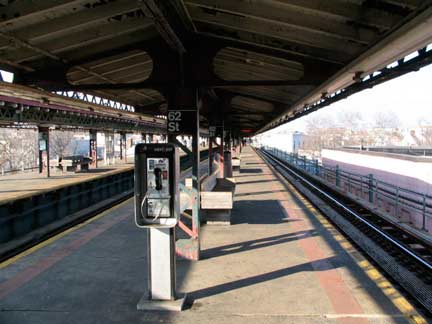
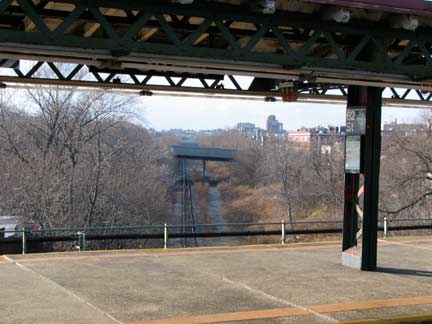
The 62nd Street station has even greater potential as a transit hub. In 2008 MTA chief Elliott sander proposed deploying the old LIRR Bay Ridge Branch (which after an initial heyday as a ferry-bound passenger line eliminated revenue traffic in Bay Ridge in 1904) as a new crosstown subway. Today, it has only occasional freight runs. As you can see onthis link, the line intersects several established Manhattan-bound lines. Thus, it’s feasible that three separate subway lines may meet here in the future.
The Bay Ridge Branch did see passenger service after 1904, but only for soldiers who were being transported to the Brooklyn Army Terminal for deployment overseas. In 1958, one of the soldiers who rode the line was Elvis Presley.
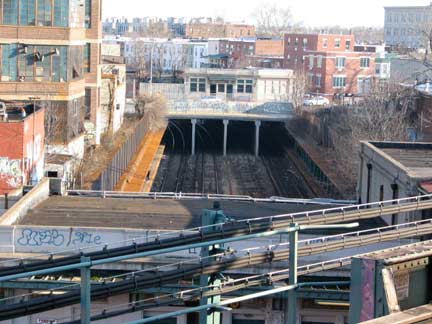
Above: the Sea Beach line runs under the West End el at 62nd Street.
I have my doubts about whether a line that will not reach Manhattan will ever get enough support. As I commented in Queens Crap:
Using abandoned railroads to create subways makes WAY too much sense to ever happen in NYC, where when the money gets tight, transit projects are the first to go. People who matter, people with money, go places by cab or limo.
The [Manhattan West Side] High Line should, ideally, have been the southwestern extension of the #7 train. The infrastructure was in place, for Pete’s sake. Yet when CSX sold it to the city one of the stipulations was that it NOT be used for transit. So, what we’ll get is a very haute, stylized elevated walkway. Better than a poke in the eye, I suppose.
The western end of the LIRR’s “Montauk” branch, running through Forest Hills, Glendale, Maspeth, Blissville and LIC, was neglected and effectively abandoned as passenger service for the railroad for decades, and finally, the purchase of new equipment 8 years ago gave the LIRR the excuse it needed to cancel whatever meager service there remained.
Despite the fact that it ran to LIC/Hunters Point, would connect with the #7 Flushing Line, and would finally give Glendale, Fresh Pond, etc. the subway service it has long lacked, locals have fought any proposal to refit the Montauk Branch as a subway line tooth and nail.
Ditto any reactivation of the LIRR’s Rockaway Branch through Rego Park, Forest Hills and Woodhaven.
The desire to keep undesirables, ie. people not from the neighborhood OUT of the neighborhood trumps any convenience mass transit might bring to any area in NYC’s boroughs.
How is [then MTA Chairman Elliott] Sander going to raise the money to do this project and, at the same time, battle the locals who don’t want the project?
He won’t.
Photographed March 1, 2008; page completed March 9, 2008
erpietri@earthlink.net
©2008


